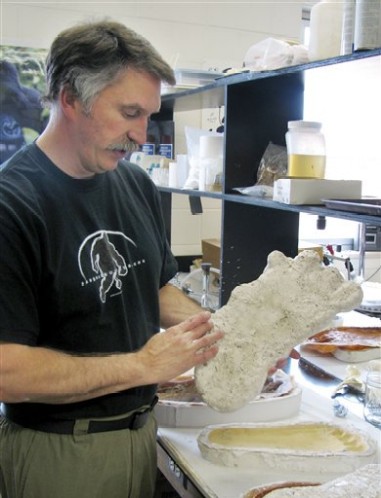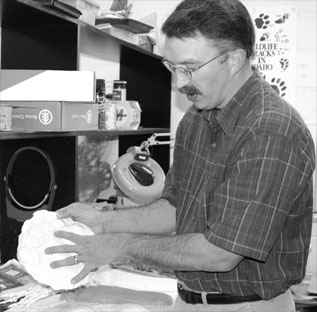Anthropoidipes ameriborealis
Posted by: Loren Coleman on November 7th, 2007
Some species have been described and accepted by science, merely from their footprints. This has occurred most famously with dinosaurs.
Jeff Meldrum, Ph. D., Idaho State University, has come forth with a new moniker by which we may talk about Sasquatch. But it is not a “new name” for Bigfoot. Meldrum has given the tracks a new label, Anthropoidipes ameriborealis (“North American ape foot”), in his just-published paper, “Ichnotaxonomy of Giant Hominid Tracks in North America.”
Meldrum sends along this:
“Point of clarification — Anthropoidipes ameriborealis is NOT a proposed name for sasquatch. It is a published name for tracks/footprints that have been attributed to Sasquatch. Ichnotaxonomy is a linnaean system for naming tracks and traces separate and distinct from the taxonomy of the organisms themselves. It can be applied even if the trackmaker has not been identified, hence its utility in this situation. The paper does not validate the existence of Sasquatch, but recognizes the existence of large unidentified tracks and puts a handle on them. This should also increase discussion of the footprint data.”

Meldrum’s abstract follows:
Abstract—Large bipedal hominoid footprints, commonly attributed to Bigfoot or sasquatch, continue to be discovered and documented, occasionally in correlation with eyewitness sightings, and rarely in concert with photographic record of the trackmaker (gen. et sp. indet.). One of the best-documented instances occurred in 1967, when Roger Patterson and Bob Gimlin filmed an over two meter tall upright striding hominoid figure, at the site of Bluff Creek, in Del Norte County, California, and cast a right and left pair of exceptionally clear footprints in firm moist sand. Additional footprints were filmed, photographed, and cast by multiple witnesses. Molds and casts of a series of these are reposited at the National Museum of Natural History, Smithsonian Institution, while ten original casts are among the Titmus Collection at the Willow Creek – China Flats Museum, Humboldt County, California. These casts have been 3D-scanned and archived as part of a footprint virtualization project and scan images are accessible on-line through the Idaho Museum of Natural History. The initial pair, originally cast by Patterson, and the remaining casts made by Titmus, are designated the holotype of a novel ichnogenus and ichnospecies describing these plantigrade pentadactyl bipedal primate footprints – Anthropoidipes ameriborealis (“North American ape foot”). The footprints imply a primitively flat, flexible foot lacking a stiff longitudinal arch, combined with a derived, non-divergent medial digit.
Download the paper here: Ichnotaxonomy of Giant Hominid Tracks in North America

There is a long history of formally attempting to tie Bigfoot to Latin scientific names. I posted an update of my examination of the subject in “Sasquatch Scientific Names.”
The late anthropologist Grover Krantz proposed for the Sasquatch, Gigantopithecus blacki, but had a backup moniker too. If in fact Bigfoot is a different species of this genus, then Krantz suggested naming it Gigantopithecus canadensis. As Grover Krantz pointed out, canadensis “is a commonly used zoological name for species that are native to northern North America.”
It appears Meldrum had similar thoughts, but went with ameriborealis and linked the genus name with the tracks. (I was delighted to see that despite past bouts with disinformation where attempts were made to besmear Meldrum’s name, he has trekked steadfastly right along and got published this ground-breaking peer-reviewed paper on Sasquatch tracks.)
Other choices than Meldrum’s, of course, may come into play if a living specimen or body shows any kind of alignment to previous fossil candidates. As long ago as 1971, Gordon Strasenburgh noted that Bigfoot would be found to be related to Paranthropus robustus. He proposed the name Paranthropus eldurrelli to be specifically used for the Pacific Northwest Bigfoot.
For other names that have been proposed for Bigfoot and other hairy unknown hominoids, please see here.
About Loren Coleman
Loren Coleman is one of the world’s leading cryptozoologists, some say “the” leading living cryptozoologist. Certainly, he is acknowledged as the current living American researcher and writer who has most popularized cryptozoology in the late 20th and early 21st centuries.
Starting his fieldwork and investigations in 1960, after traveling and trekking extensively in pursuit of cryptozoological mysteries, Coleman began writing to share his experiences in 1969. An honorary member of Ivan T. Sanderson’s Society for the Investigation of the Unexplained in the 1970s, Coleman has been bestowed with similar honorary memberships of the North Idaho College Cryptozoology Club in 1983, and in subsequent years, that of the British Columbia Scientific Cryptozoology Club, CryptoSafari International, and other international organizations. He was also a Life Member and Benefactor of the International Society of Cryptozoology (now-defunct).
Loren Coleman’s daily blog, as a member of the Cryptomundo Team, served as an ongoing avenue of communication for the ever-growing body of cryptozoo news from 2005 through 2013. He returned as an infrequent contributor beginning Halloween week of 2015.
Coleman is the founder in 2003, and current director of the International Cryptozoology Museum in Portland, Maine.










Good going Dr. Meldrum, You are one of my scientific heros. Keep up the good work. It is good to know that Dr. Meldrum is still very involved with scientific study of sasquatch.
Loren, what do you think about his new name for Bigfoot?
I think everyone should be aware that Dr. Meldrum is not attempting to put a genus species name to sasquatch, but only a name to the tracks, so that they can be discussed in a scientific forum. Isn’t that right Dr. Meldrum?
I think he states that clearly in his paper as quoted here:
“Furthermore, a precedent for naming the preserved tracks of an extant taxon has been established by Kim et al. (in press) in the naming of fossil Homo sapiens tracks. Since faltering steps and
equivocations have been directed towards the matter of naming the footprints,it seems appropriate to complete that objective properly and formally by acknowledging the ichnological evidence that bears on the question of the existence of an unrecognized bipedal ape in the forest habitats of North America. It should be noted that naming the tracks neither establishes the identity of the trackmaker, nor does it resolve the controversy over the existence of sasquatch. Properly naming the tracks is intended to facilitate objective discussion and comparison of the tracks within an ichnological context.
I think it best to preserve an official taxonomic designation until the time comes when a Sas can be properly documented and studied. We need some bones!
However, whether when that time comes someone will choose to use the name Meldrum has designated is uncertain.
Surely any name first chosen will be argued, changed, and argued about again.
this is a wonderful article about dr. jeff meldrum & sasquatch. it realy helped me with my research. thanks bill green
I finally read through the paper in its entirety, (even though the small print on my computer hurt my eyes a bit!), and in my opinion it is very well done. I recommend everybody here reads it in full. It is good to see a serious, solid published scientific paper like this on a cryptozoological subject that is out there making the rounds. I think Meldrum is truly doing a great deal towards making the pursuit of sasquatch a more acceptable scientific endeavor and I am thrilled to see that this is an actual peer reviewed, published paper. I really would like to see more work like this done on all fronts of cryptozoology and see this field come to be regarded as an honest scientific venture rather than being categorized as some sort of fringe pseudo science by the general public. Kudos to Meldrum for approaching the subject matter in a thorough, thoughtful, and scientific way.
Kudos to Dr Meldrum for advancing the study of Bigfoot/sasquatch to a higher level (at great risk to his academic reputation). It is refreshing to see someone of Jeff’s credentials who views biology/crytozoology as a living science. Someone who still sees science as a pursuit of discovery…not simply a process of exponding on already “established knowledge.” It’s people like Jeff and Loren who give us hope that our collective quest is a worthy cause. Keep up the good work!
Todd Neiss
Independent Bigfoot Researcher
Sandy, Oregon
I look forward to seeing the actual peer reviews…Game on!
I think that this approach is sensible. Since there exists quite an extensive number of track casts, providing such a body of evidence with a Latin scientific name is proper-thank you, Dr. Meldrum. Of course, since we lack the physical evidence which would justify naming the animal itself, this should wait until such evidence becomes available. The horse first-THEN the cart.
Meldrum is one of the best researchers in the field of cryptozoology that I think. Keep up the good work!
i don’t think the basis for the name change…just a belief system (even if based on what the researcher feels is compelling evidence)…is adequate. don’t you usually make the discovery and THEN name the newly discovered species? It’s not going to give bigfoot researchers any more credibility..but it’s had so many names thru the years and native cultures one more won’t hurt i guess. jeff Meldrum is such a plus for the field…well spoken, intelligent and CUTE.